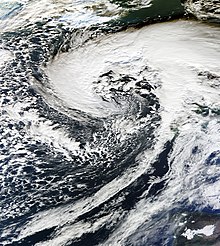Naming of winter storms in Ireland and the United Kingdom
The naming of winter storms in Ireland and the United Kingdom was jointly introduced by the British Met Office and its Irish counterpart Met Éireann . The decision to introduce a naming scheme was made in the wake of the St Jude's Day Storm - known in German-speaking countries as Orkan Christian - which passed across Europe on October 27 and 28, 2013, killing 17 people and the 2013/2014 winter storms, to prevent confusion in the media and the public by specifying uniform names, as these sometimes use different names for the same storms.
The first storm under the new system was named Abigail on November 10, 2015.
reasons
According to the weather services involved, the following prerequisites for the decision were:
- Raising awareness of the dangers posed by storms
- Increase security for the public
- Avoiding confusion if the extra-tropical follow-up system to a hurricane hits Europe
- Public participation
- Cooperation across borders
The names are to be given to large-scale cyclonic storms with the potential for significant effects on land. This can lead to systems being given names whose intensity is below the traditional definition of a storm on the Beaufort scale .
Naming
A storm is designated when it can be assumed that it will have a “significant” impact on Ireland or the United Kingdom in the further course. Met Éireann gives each storm a name that triggers a weather warning with the status orange or red, with the focus on the wind strength, whereby the amount of rain and the amount of snowfall are also taken into account in 2016/2017. The basis for such wind warnings are mean winds of more than 65 km / h or gusts of more than 110 km / h. Similarly, the Met Office names those storms that have the potential to have a moderate (“amber”) or strong (“red”) impact on the UK, with less wind force than actual impacts such as falling trees, falling trees Roof tiles and objects blown around by the wind (e.g. garden furniture) are a criterion.
For storms with a name, weather warnings with the status "Amber" or "Red" are issued.
If previous tropical storms or hurricanes approach the British Isles, the names given by the National Hurricane Center in Miami will continue to be used.
The less frequently occurring initial letters Q, U, X, Y and Z are not used.
In September 2015, the two weather services surveyed the public as part of the Name our storms campaign and then selected the first set of names.
With the 2019/2020 season, the Dutch KNMI is participating in the cooperation between Met Office and Met Éireann, and therefore Dutch names have also been recognized since then.
Irish / British storm names
| 2015–16 | 2016–17 | 2017-18 | 2018–19 | 2019-20 |
|---|---|---|---|---|
|
|
|
|
|
italic: name not used (until 2019)
See also
- Assigning names for weather events - an overview
- Atlantic hurricane season
supporting documents
- ↑ Storm-naming system yet to be put in place as Rachel peters out (English) , Irish Times. January 15, 2015. Retrieved March 18, 2017.
- ^ Met Éireann plans to start naming storms from next year (English) , The Journal. December 21, 2014. Retrieved March 18, 2017.
- ^ The power of a name (English) , Met Office. August 3, 2016. Retrieved March 18, 2017.
- ^ Abigail, First British Storm Ever Named, Slams Scotland, Ireland ( English ) NBC News. November 12, 2015. Retrieved March 18, 2017.
- ^ Met Éireann and the UK Met Office release list of winter storm names ( English ) Met Éireann . November 10, 2015. Retrieved March 18, 2017.
- ^ Met Éireann: Met Éireann - The Irish Weather Service (English) . In: www.met.ie , October 14, 2016. Retrieved March 18, 2017.
- ^ Met Éireann Weather Warning System Explained ( English ) Met Éireann. Retrieved March 18, 2017.
- ↑ (January 25, 2016). When would we name a storm? [Video]. The Met Office. 18th March 2017.
- ↑ Help the Met Office and Met Éireann name our storms this winter ( English ) Met Office gov.uk. September 8, 2015. Archived from the original on September 24, 2015. Retrieved on March 18, 2017.
- ↑ UK Storm Season 2015/16. In: metoffice.gov.uk. Retrieved January 7, 2018 .
- ↑ UK storm season 2016/17. In: metoffice.gov.uk. Retrieved January 7, 2018 .
- ↑ UK storm season 2017/18. In: metoffice.gov.uk. Retrieved February 10, 2020 .
- ↑ UK storm season 2018/19. In: metoffice.gov.uk. Retrieved February 10, 2020 .
- ^ UK Storm Center. In: metoffice.gov.uk. Retrieved February 10, 2020 .
